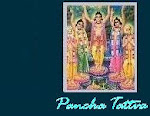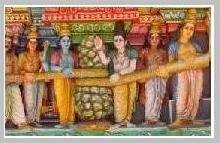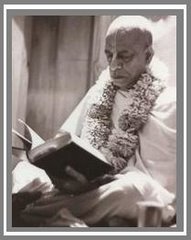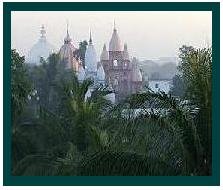
While carried by the constables of Yamaräja, he is overwhelmed and trembles in their hands. While passing on the road he is bitten by dogs, and he can remember the sinful activities of his life. He is thus terribly distressed.
Under the scorching sun, the criminal has to pass through roads of hot sand with forest fires on both sides. He is whipped on the back by the constables because of his inability to walk, and he is afflicted by hunger and thirst, but unfortunately there is no drinking water, no shelter and no place for rest on the road.
While passing on that road to the abode of Yamaräja, he falls down in fatigue, and sometimes he becomes unconscious, but he is forced to rise again. In this way he is very quickly brought to the presence of Yamaräja.
Thus he has to pass ninety-nine thousand yojanas within two or three moments, and then he is at once engaged in the torturous punishment which he is destined to suffer.
He is placed in the midst of burning pieces of wood, and his limbs are set on fire. In some cases he is made to eat his own flesh or have it eaten by others.
His entrails are pulled out by the hounds and vultures of hell, even though he is still alive to see it, and he is subjected to torment by serpents, scorpions, gnats and other creatures that bite him.
Next his limbs are lopped off and torn asunder by elephants. He is hurled down from hilltops, and he is also held captive either in water or in a cave.
Men and women whose lives were built upon indulgence in illicit sex life are put into many kinds of miserable conditions in the hells known as Tämisra, Andha-tämisra and Raurava.
Lord Kapila continued: My dear mother, it is sometimes said that we experience hell or heaven on this planet, for hellish punishments are sometimes visible on this planet also.
After leaving this body, the man who maintained himself and his family members by sinful activities suffers a hellish life, and his relatives suffer also.
He goes alone to the darkest regions of hell after quitting the present body, and the money he acquired by envying other living entities is the passage money with which he leaves this world.
Thus, by the arrangement of the Supreme Personality of Godhead, the maintainer of kinsmen is put into a hellish condition to suffer for his sinful activities, like a man who has lost his wealth.
Therefore a person who is very eager to maintain his family and kinsmen simply by black methods certainly goes to the darkest region of hell, which is known as Andha-tämisra.
Having gone through all the miserable, hellish conditions and having passed in a regular order through the lowest forms of animal life prior to human birth, and having thus been purged of his sins, one is reborn again as a human being on this earth.
The Personality of Godhead said: Under the supervision of the Supreme Lord and according to the result of his work, the living entity, the soul, is made to enter into the womb of a woman through the particle of male semen to assume a particular type of body.
On the first night, the sperm and ovum mix, and on the fifth night the mixture ferments into a bubble. On the tenth night it develops into a form like a plum, and after that, it gradually turns into a lump of flesh or an egg, as the case may be.
In the course of a month, a head is formed, and at the end of two months the hands, feet and other limbs take shape. By the end of three months, the nails, fingers, toes, body hair, bones and skin appear, as do the organ of generation and the other apertures in the body, namely the eyes, nostrils, ears, mouth and anus.
Within four months from the date of conception, the seven essential ingredients of the body, namely chyle, blood, flesh, fat, bone, marrow and semen, come into existence. At the end of five months, hunger and thirst make themselves felt, and at the end of six months, the fetus, enclosed by the amnion, begins to move on the right side of the abdomen.
Deriving its nutrition from the food and drink taken by the mother, the fetus grows and remains in that abominable residence of stools and urine, which is the breeding place of all kinds of worms.
Bitten again and again all over the body by the hungry worms in the abdomen itself, the child suffers terrible agony because of his tenderness. He thus becomes unconscious moment after moment because of the terrible condition.
Owing to the mother’s eating bitter, pungent foodstuffs, or food which is too salty or too sour, the body of the child incessantly suffers pains which are almost intolerable.
Placed within the amnion and covered outside by the intestines, the child remains lying on one side of the abdomen, his head turned towards his belly and his back and neck arched like a bow.
The child thus remains just like a bird in a cage, without freedom of movement. At that time, if the child is fortunate, he can remember all the troubles of his past one hundred births, and he grieves wretchedly. What is the possibility of peace of mind in that condition?
Thus endowed with the development of consciousness from the seventh month after his conception, the child is tossed downward by the airs that press the embryo during the weeks preceding delivery. Like the worms born of the same filthy abdominal cavity, he cannot remain in one place.
The living entity in this frightful condition of life, bound by seven layers of material ingredients, prays with folded hands, appealing to the Lord, who has put him in that condition.
The human soul says: I take shelter of the lotus feet of the Supreme Personality of Godhead, who appears in His various eternal forms and walks on the surface of the world. I take shelter of Him only, because He can give me relief from all fear and from Him I have received this condition of life, which is just befitting my impious activities.
I, the pure soul, appearing now bound by my activities, am lying in the womb of my mother by the arrangement of mäyä. I offer my respectful obeisances unto Him who is also here with me but who is unaffected and changeless. He is unlimited, but He is perceived in the repentant heart. To Him I offer my respectful obeisances.
I am separated from the Supreme Lord because of my being in this material body, which is made of five elements, and therefore my qualities and senses are being misused, although I am essentially spiritual. Because the Supreme Personality of Godhead is transcendental to material nature and the living entities, because He is devoid of such a material body, and because He is always glorious in His spiritual qualities, I offer my obeisances unto Him.
No one other than the Supreme Personality of Godhead, as the localized Paramätmä, the partial representation of the Lord, is directing all inanimate and animate objects. He is present in the three phases of time—past, present and future. Therefore, the conditioned soul is engaged in different activities by His direction, and in order to get free from the threefold miseries of this conditional life, we have to surrender unto Him only.
Fallen into a pool of blood, stool and urine within the abdomen of his mother, his own body scorched by the mother’s gastric fire, the embodied soul, anxious to get out, counts his months and prays, “O my Lord, when shall I, a wretched soul, be released from this confinement?”
My dear Lord, by Your causeless mercy I am awakened to consciousness, although I am only ten months old. For this causeless mercy of the Supreme Personality of Godhead, the friend of all fallen souls, there is no way to express my gratitude but to pray with folded hands.
The living entity in another type of body sees only by instinct; he knows only the agreeable and disagreeable sense perceptions of that particular body. But I have a body in which I can control my senses and can understand my destination; therefore, I offer my respectful obeisances to the Supreme Personality of Godhead, by whom I have been blessed with this body and by whose grace I can see Him within and without.
Therefore, my Lord, although I am living in a terrible condition, I do not wish to depart from my mother’s abdomen to fall again into the blind well of materialistic life. Your external energy, called deva-mäyä, at once captures the newly born child, and immediately false identification, which is the beginning of the cycle of continual birth and death, begins.
Therefore, without being agitated any more, I shall deliver myself from the darkness of nescience with the help of my friend, clear consciousness. Simply by keeping the lotus feet of Lord Vishnu in my mind, I shall be saved from entering into the wombs of many mothers for repeated birth and death.
Lord Kapila continued: The ten-month-old living entity has these desires even while in the womb. But while he thus extols the Lord, the wind that helps parturition propels him forth with his face turned downward so that he may be born.
Pushed downward all of a sudden by the wind, the child comes out with great trouble, head downward, breathless and deprived of memory due to severe agony.
The child thus falls on the ground, smeared with stool and blood, and plays just like a worm germinated from the stool. He loses his superior knowledge and cries under the spell of mäyä.
After coming out of the abdomen, the child is given to the care of persons who are unable to understand what he wants, and thus he is nursed by such persons. Unable to refuse whatever is given to him, he falls into undesirable circumstances.
Laid down on a foul bed infested with sweat and germs, the poor child is incapable of scratching his body to get relief from his itching sensation to say nothing of sitting up, standing or even moving.
In his helpless condition, gnats, mosquitoes, bugs and other germs bite the baby, whose skin is tender, just as smaller worms bite a big worm. The child, deprived of his wisdom, cries bitterly.
In this way, the child passes through his childhood, suffering different kinds of distress, and attains boyhood. In boyhood also he suffers pain over desires to get things he can never achieve. And thus, due to ignorance, he becomes angry and sorry.
With the growth of the body, the living entity, in order to vanquish his soul, increases his false prestige and anger and thereby creates enmity towards similarly lusty people.
By such ignorance the living entity accepts the material body, which is made of five elements, as himself. With this misunderstanding, he accepts nonpermanent things as his own and increases his ignorance in the darkest region.
For the sake of the body, which is a source of constant trouble to him and which follows him because he is bound by ties of ignorance and fruitive activities, he performs various actions which cause him to be subjected to repeated birth and death.
If, therefore, the living entity again associates with the path of unrighteousness, influenced by sensually minded people engaged in the pursuit of sexual enjoyment and the gratification of the palate, he again goes to hell as before.
He becomes devoid of truthfulness, cleanliness, mercy, gravity, spiritual intelligence, shyness, austerity, fame, forgiveness, control of the mind, control of the senses, fortune and all such opportunities.
One should not associate with a coarse fool who is bereft of the knowledge of self-realization and who is no more than a dancing dog in the hands of a woman.
The infatuation and bondage which accrue to a man from attachment to any other object is not as complete as that resulting from attachment to a woman or to the fellowship of men who are fond of women.
Amongst all kinds of living entities begotten by Brahmä, namely men, demigods and animals, none but the sage Narayana is immune to the attraction of mäyä in the form of woman.
Just try to understand the mighty strength of My mäyä in the shape of woman, who by the mere movement of her eyebrows can keep even the greatest conquerors of the world under her grip.
One who aspires to reach the culmination of yoga and has realized his self by rendering service unto Me should never associate with an attractive woman, for such a woman is declared in the scripture to be the gateway to hell for the advancing devotee.


































